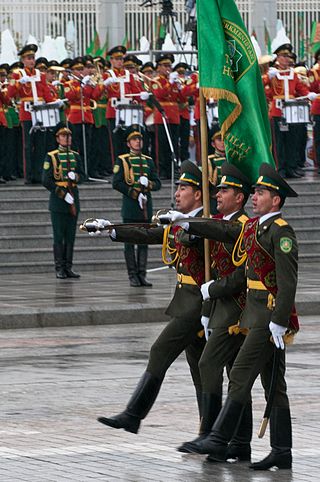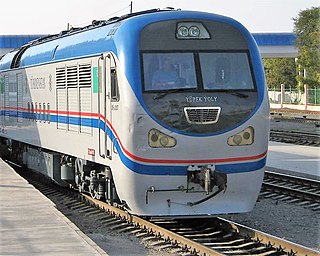
The history of Turkmenistan traditionally began with the arrival of Indo-European Iranian tribes around 2000 BC. Early tribes were nomadic or semi-nomadic due to the arid conditions of the region, preventing widespread adoption of agriculture. The steppe culture in Central Asia was an extension of a larger Eurasian series of horse cultures which spanned the entire spectrum of language families, including the Indo-Europeans and Turko-Mongol groups. Some of the known early Iranian tribes included the Massagatae, the Scythians/Sakas, and early Soghdians, who were most likely precursors of the Khwarezmians. Turkmenistan was a passing point for numerous migrations and invasions by tribes, which gravitated towards the settled regions of the south, including ancient Mesopotamia, Elam, and the Indus Valley civilization.

The politics of Turkmenistan nominally takes place in the framework of a presidential republic, whereby the President of Turkmenistan is nominally both head of state and head of government. However, as of 21 January 2023 a "national leader" was appointed who chairs an independent People's Council (viz.) with authority to amend the constitution, and who exercises supreme political authority. No true opposition parties are allowed; every registered political party supports the third and current President Serdar Berdimuhamedow. The country is frequently described as a totalitarian state.

The economy of Turkmenistan continues to recover from the 2014 downturn in hydrocarbon prices, but remains "in the grip of its worst economic crisis since the immediate post-independence period, driven in part by low gas prices, the suspension of gas exports to Russia between 2016 and 2019...and poor harvests." Former President Gurbanguly Berdimuhamedow at a session of the Cabinet of Ministers on March 11, 2021, called the rate of GDP growth unsatisfactory. When discussing the 2021 government budget, he noted that 2021 would be "as difficult" a year as 2020 had been.

Turkmenistan's declaration of "permanent neutrality" was formally recognized by the United Nations in 1995. Former President Niyazov stated that the neutrality would prevent Turkmenistan from participating in multi-national defense organizations, but allows military assistance. Its neutral foreign policy has an important place in the country's constitution. Although the Government of Turkmenistan claims to favour trade with and export to the United States, and Turkey, its single largest commercial partner is China, which buys the vast bulk of Turkmen natural gas via the Central Asia–China gas pipeline. Turkmenistan has significant commercial relationships with Russia and Iran and growing cross-border trade with Afghanistan. The Government of Turkmenistan often appears to use the conflicting interests of these regional powers as a means to extract concessions, especially on energy issues.

Ashgabat or Asgabat, formerly named Poltoratsk between 1919 and 1927, is the capital and the largest city of Turkmenistan. It lies between the Karakum Desert and the Kopetdag mountain range in Central Asia, near the Iran-Turkmenistan border. The city has a population of 1,030,063.

Turkmenistan is a landlocked country in Central Asia bordered by Kazakhstan to the northwest, Uzbekistan to the north, east and northeast, Afghanistan to the southeast, Iran to the south and southwest and the Caspian Sea to the west. Ashgabat is the capital and largest city. It is one of the six independent Turkic states. With a population of 6.5 million, Turkmenistan is the 35th most-populous country in Asia and has the lowest population of the Central Asian republics while being one of the most sparsely populated nations on the Asian continent.

The Turkmen Soviet Socialist Republic, also known as Soviet Turkmenistan, the Turkmen SSR, Turkmenistan, or Turkmenia, was one of the constituent republics of the Soviet Union located in Central Asia existed as a republic from 1925 to 1991. Initially, on 7 August 1921, it was established as the Turkmen Oblast of the Turkestan ASSR before being made, on 13 May 1925, a separate republic of the USSR as the Turkmen SSR.

Turkmenistan's human rights record has been heavily criticized by various countries and scholars worldwide. Standards in education and health declined markedly during the rule of President Saparmurat Niyazov.

The Ministry for National Security or MNS is the secret police agency for the government of Turkmenistan. It is composed largely of the remnants of KGB organs left over after the collapse of the Soviet Union; its functions remain largely the same as well. The MNB and the national police force are under the direction of the Ministry of Internal Affairs. Until 2002, it was known as the KNB.

Healthcare in Malaysia is mainly under the Ministry of Health. Malaysia generally has an efficient and widespread system of health care, operating a two-tier health care system consisting of both a government base universal healthcare system and a co-existing private healthcare system. While there is a universal healthcare system, specialist services require queuing despite being free. Hence the private health care plays a major role in providing specialist services which complements the universal health care.

The following outline is provided as an overview of and topical guide to Turkmenistan:
The 1948 Ashgabat earthquake was on 6 October with a surface wave magnitude of 7.3 and a maximum Mercalli intensity of X (Extreme), in Turkmenistan near Ashgabat. Due to censorship by the Soviet government, the event was not widely reported in the USSR's media. Historians tend to agree that the ban on reporting the extent of the casualties and damage did not allow the Soviet government to allocate enough financial resources to respond adequately. It was the strongest earthquake recorded in Turkmenistan.

The Republic of Uzbekistan has an embassy in Ashgabat. Turkmenistan has an embassy in Tashkent. Both countries were previously subordinated republics of the Soviet Union as Turkmen Soviet Socialist Republic and Uzbek Soviet Socialist Republic before its collapse in 1991.

Saparmurat Atayevich Niyazov, also known as Türkmenbaşy, was a Turkmen politician who ruled Turkmenistan from 1985 until his death in 2006. He was first secretary of the Turkmen Communist Party from 1985 until 1991 and supported the 1991 Soviet coup attempt. He continued to rule Turkmenistan for 15 years after independence from the Soviet Union in 1991.

The list of Turkmenistan-related articles is below

The Railways Agency of Turkmenistan (Turkmen: "Türkmendemirýollary" agentligi, previously the Ministry of Railways, is a government agency in Turkmenistan responsible for oversight of the state rail corporation "Demirýollary" AGPJ.

The Turkmen Ground Forces is the army branch of the Armed Forces of Turkmenistan. The ground forces include the 2nd, 3rd, 11th, and 22nd Motor Rifle Divisions as well as smaller units consisting of various types of troops.
Magtymguly Avenue, transliterated from Russian as Makhtumkuli, is an avenue in Ashgabat, Turkmenistan. It is considered to be the longest and most prominent avenue in the capital

The Armed Forces of Turkmenistan currently funds 2 high ranking educational institutions: The Military Academy of Turkmenistan and the Military Institute of the Ministry of Defense of Turkmenistan. Aside from those two schools, there are several military schools around the country, specializing in the training of personnel of a branches of service. In the early 1990s when the armed forces were rapidly being developed, many officers were trained in the Russian Federation's Ministry of Defense, while at least 300 officers were sent to schools in Turkey. On 3 October 1992, the Turkmen State University created the first Turkmen educational department. This article lists institutions of the Turkmen Armed Forces based on its respective agency and service branch.

The Walk of Health is a 36-kilometre (22 mi) long concrete walkway that runs alongside the Kopet Dag mountain range in south Ashgabat, Turkmenistan, near the Iran–Turkmenistan border. The first 8 km (5.0 mi) of the path was constructed in 1999 by dictator Saparmurat Niyazov, with the intent of encouraging citizens to be healthy. It officially opened on 2 January 2000. Until Niyazov's death, he required his ministers to walk the walkway once every year.














